Honey Sweetened Concord Grape Jelly
This post may contain affiliate links, which means that I may receive a commission if you make a purchase using these links. As an Amazon Associate I earn from qualifying purchases.
Make and preserve your own homemade Concord grape jelly! Concord grapes have a slightly tart, musky flavor but can be transformed into a delicious grape jelly with a little sweetening. This old-time favorite is sweetened with honey in this recipe.
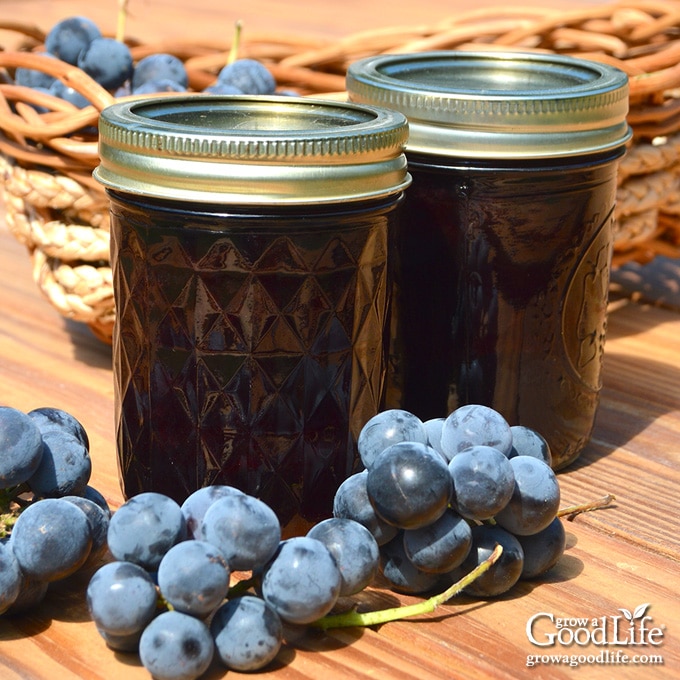
Concord grapes are behind the flavor of grape jelly traditionally used in peanut butter and jelly sandwich that many of us grew up eating. Ephraim Wales Bull originally developed the Concord grape in 1849 at his farm in Concord, Massachusetts. The variety was cultivated from native grape species that thrive in the cold climate of New England. The vines are so hearty that it isn’t unusual to find them growing wild on old homesteads, in the woods, and along streambeds.
Our Concord grape vines were overgrown when we purchased our property, and they continue to be a work in progress. Last year, we hacked the vines that escaped the trellis and wound their way up the nearby pine trees. We were unforgiving and cut the mature grape vines back about 90% almost to their trunk.
It doesn’t take long for vigorous grape vines to become unruly, and ideally they should be pruned every year when vines are dormant. It had been several years since we had pruned the vines, and the grape production dwindled a little each year because the plants’ energy was diverted into too many directions. It was time to reel it in.
Grapes bear fruit on one-year-old canes, so we had to wait patiently a few years until the vines produced. We didn’t have a large harvest of grapes this year, but it was enough for a small batch of Concord grape jelly.
Tips for Making Concord Grape Jelly
This jelly recipe uses Concord grapes, but feel free to try it with other grape varieties. The flavor will be different, but still delicious. You can also make this jelly with purchased frozen or bottled grape juice if you don’t have fresh fruit.
Harvest the Grapes at Peak Sweetness
The best way to tell if the grapes are ready to harvest is by tasting them and checking the seed color. As the fruit ripens, it will become sweet and the seeds will change from green to brown.
Make Small Batches of Grape Jelly
I know it may be tempting, especially if you have lots of grapes, but don’t double this recipe. Small batches are much easier to manage ingredients, heat, and get the jelly to gel successfully. If you have a lot of grapes, consider freezing or canning grape juice for later.
Use Pomona’s Universal Pectin
This recipe for grape jelly uses Pomona’s Universal Pectin. It is a citrus pectin that lets you use less sugar and other sweetening alternatives than your typical boxed pectin. It works differently than regular pectin in that it uses calcium powder to gel instead of lots of sugar. This allows the fruit flavor to shine in your jellies and jams rather than the sweetness of the sugar. You can find Pomona’s Universal Pectin in stores with the canning supplies or online.
Allow Plenty of Time
When making jelly from fresh fruit, you will need a couple of days to extract the juice and allow the sediment to settle.
Concord grapes have a lot of sediment and can form tartrate crystals. Allowing the juice to rest overnight in the refrigerator will let the residue separate from the juice and settle on the bottom of the container.
Use a Mild Flavored Honey
Depending on where the honeybees gather nectar, the flavor of honey can range from mild to bold. You will want to choose a mild honey to sweeten jelly so the honey flavor won’t overwhelm the grapes. Generally, light-colored honey made from alfalfa or clover is milder in taste.
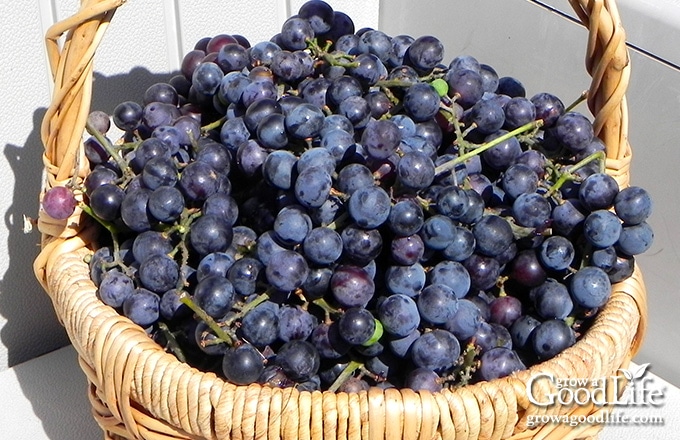
How to Make Grape Jelly
This homemade grape jelly is made by extracting the juice from homegrown Concord grapes, sweetening with honey, thickened with Pomona’s Universal Pectin, and processed in a boiling water bath canner for shelf stable jars.
Don’t have access to fresh Concord grapes? You can also make jelly with frozen or bottled grape juice that can be purchased at the grocery store. You will need 4 cups of juice for this recipe.
If you are new to canning or haven’t canned in a while, it may be helpful to review this article on water bath canning at the National Center for Home Food Preservation website.
A more detailed and printable recipe can be found at the bottom of this post, but these are the general steps for making Concord Grape Jelly from fresh fruit.
Step 1: Gather Your Canning Equipment
- Water bath canner with a canning rack
- 5 half-pint canning jars
- Canning lids and bands (new lids, bands can be reused)
- Canning tools: jar lifter, canning ladle, funnel, and bubble popper
- Jelly strainer or cheese cloth
- Kitchen Scale
- Small clear jar with a lid for the calcium water
- Plus basic kitchen supplies such as a large prep bowl, large sauce pot, spoons, towels, potato masher, and measuring spoons and cups.
Step 2: Prepare the Grapes
Harvest the grapes at peak sweetness. Pluck the grapes from the stems and rinse well in plain water to remove bugs, dust, and debris. You’ll need about 4 pounds of grapes to make 4 cups of juice.
Step 3: Extract the Juice from the Fruit
Extract the juice by combining the grapes and water in a large saucepan. Bring to a boil over medium-high heat, and then reduce to a simmer. Gently mash the grapes with a potato masher to release their juices and continue simmering over low heat for 10 minutes, stirring occasionally.
Strain the juice through a damp jelly bag or double layers of cheesecloth. Let the fruit strain for several hours. If you want clear jelly, do not squeeze the bag. I care more for flavor rather than appearance, so I often give the bag a squeeze to press out all the flavorful juice. Discard the solids.
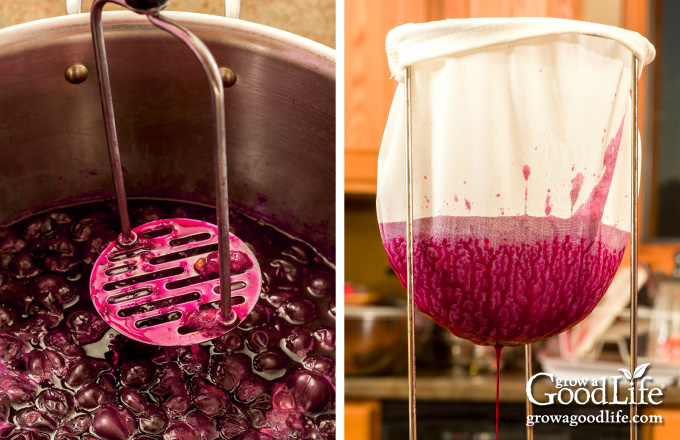
Step 4: Refrigerate the Grape Juice
Place the juice into the refrigerator to sit for 24-48 hours. During this time, tartaric acid crystals will form, and the sediment will settle to the bottom.
Step 5: Prepare the Canning Equipment
When you are ready to make the jelly, wash your jars, lids, bands, and canning tools in warm, soapy water. Rinse well, and set aside until you are ready to use them.
Jars must be heated before filling to prevent breakage due to thermal shock. Place the jar rack into the water bath canner, set the jars upright on the rack, and add water to fill the pot covering the jars. Bring the canner to a simmer (180˚F) for 10 minutes, and keep the jars hot until you are ready to fill them.
Follow the manufacturer’s directions for preparing the lids. Pre-heating lids is no longer necessary before using, but it is still safe to simmer (180°F) the lids if you want to. Just place lids in the canner while you heat your jars.
Step 6: Mix the Calcium Water
Pomona’s Universal Pectin uses calcium water to get the jelly to thicken and gel. Make this by combining 1/2 teaspoon calcium powder (from the small packet in the Pomona’s pectin box) with 1/2 cup water in a glass jar with a lid. Shake well and set aside. You will need 4 teaspoons of calcium water for this recipe. Store extra in the refrigerator for other canning recipes.
Step 7: Make the Grape Jelly
In a small bowl or measuring cup, combine the honey with the pectin powder. Set aside.
Remove the grape juice from the refrigerator without disturbing the settlement at the bottom. Strain the juice again through a jelly bag or double layers of cheesecloth to remove the crystals. Stop when you see the sediment reach the lip of the container. The jelly bag or cheesecloth will catch the crystals.
Measure out 4 cups of the juice into a large saucepan. Add the lemon juice, calcium water, and stir to mix well. Bring juice to a boil over medium-high heat.
Add the pectin-honey mixture and stir to dissolve. Continue stirring until the jelly comes back to a boil. Once it boils, remove from heat and skim off foam.
Step 8: Can the Jelly
Spread a kitchen towel on the counter. Use the jar lifter to remove a jar from the canner, drain, and place on the towel. Keep the remaining jars in the canner so they stay hot.
With the canning funnel and ladle, add jelly to the jar leaving 1/4-inch headspace. Run the bubble popper through the jar to release any trapped air bubbles.
Wipe the rim with a damp towel to remove any residue. Center a lid on the jar, place the band over the lid, and screw it on until fingertip tight. Place the jar back into the canner, and repeat with the rest of the jars.
Once the jars are in the canner, adjust the water level so it is covering the jars by two inches, bring the canner to a boil, and process the jars for the times indicated in the recipe below.
Let the jars cool completely, and then test the seals. Refrigerate any jars that failed to seal. Remove the bands and wash the jars well with warm soapy water to remove any residue. Label, date, and store in a cool, dark place, between 50 to 70 degrees F. Use within 12 to 18 months. Refrigerate the jar once opened and consume within 3 weeks.
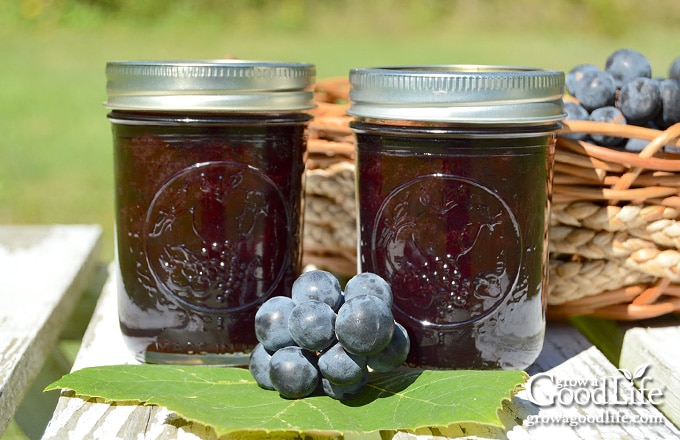
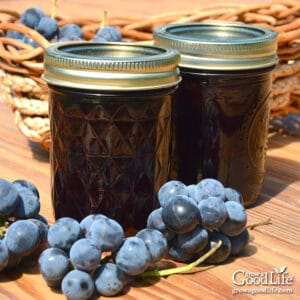
Honey Sweetened Concord Grape Jelly
Ingredients
- 4 pounds Concord grapes
- 1/2 cup water
- 1/2 cup honey (or 3/4 cupsugar)
- 4 teaspoons Pomona’s Universal Pectin (included in the Pomona box)
- 1/4 cup lemon juice fresh or bottled
- 4 teaspoons calcium water (included in the Pomona box-see instructions)
Instructions
Extract the Grape Juice
- Remove the grapes from the stems and wash in plain water.
- Extract the juice by combining the fruit and water in a large saucepan. Bring to a boil over medium-high heat then reduce to a simmer (180˚F) over low heat.
- Gently mash the grapes with the back of a spoon or potato masher to release their juices and continue simmering over low heat for 10 minutes, stirring occasionally.
- Strain the fruit through a damp jelly bag or double layers of cheesecloth for several hours. Don't squeeze the bag if you want clear jelly.
- Discard the solids and refrigerate the juice overnight to allow the sediment and crystals to settle.
Mix the Calcium Water
- Prepare your calcium water by combining 1/2 teaspoon calcium powder (from the small packet in the Pomona's pectin box) with 1/2 cup water in a jar with a lid. Shake well to combine. Set aside.
- You will only need 4 teaspoons of calcium water for this recipe. Store extra in the refrigerator for other canning projects.
Prepare the Canning Equipment
- Wash your jars, lids, and canning tools in hot soapy water. Rinse thoroughly to remove all suds. Set aside to air dry on a clean kitchen towel.
- Place the jar rack into water bath canner, set the jars on the rack, and add water to cover the jars.
- Bring the canner to a simmer (180˚F) for 10 minutes, and keep the jars hot until you are ready to fill them.
Make the Jelly
- In a small bowl or measuring cup, combine the honey or sugar with the pectin powder. Set aside.
- Remove the grape juice from the refrigerator without disturbing the settlement at the bottom.
- Strain the juice again through a jelly bag or double layers of cheesecloth to remove the crystals.
- Carefully pour the grape juice through the cheesecloth and into a bowl. Stop when you see the sediment reach the lip of the container. The jelly bag or cheesecloth will catch the crystals.
- Measure out 4 cups of the juice into a large sauce pan. Add lemon juice, calcium water, and stir to mix well. Bring juice to a boil over medium-high heat.
- Add the pectin-honey mixture and stir to dissolve. Continue stirring until the jelly comes back to a boil. Once it boils, remove from heat and skim off foam.
Can the Grape Jelly
- Spread a kitchen towel on the counter. Use your jar lifter to remove a jar from the canner, drain, and place on the towel. Keep the remaining jars in the canner so they stay hot.
- Use your canning ladle and funnel and add the hot cherry jam to the warm jar leaving 1/4-inch headspace. Swirl your bubble popper through the jars to release air bubbles. Wipe the rim of each jar with a damp towel.
- Center a lid on the jar, and screw on the band until it is fingertip tight. Use the jar lifter to place the jar back into the canner, and repeat with the remaining jars. Try to leave some space in between the jars.
- Once all the jars are in canner, adjust the water level to two inches above the jar tops.
- Cover the canner and bring to boil over high heat. Once water boils vigorously, continue boiling for 10 minutes at altitudes of less than 6,000 ft. Adjust processing time for your altitude if necessary. (see notes below).
- When processing time is complete, turn off heat and allow the canner to cool down and settle for about 5 minutes.
- Spread a kitchen towel on the counter, and remove the cover by tilting lid away from you so that steam does not burn your face.
- Use the jar lifter to transfer the jars from the canner to the towel.
- Don't tighten bands or check the seals yet. Let the jars sit undisturbed for 12 to 24-hours to cool.
- After the jars cool for at least 12 hours, check to be sure jar lids have sealed by pushing on the center of the lid. The lid should not pop up. If the lid flexes up and down, it did not seal. Refrigerate the jar and use up within a few weeks.
- Remove the screw on bands and wash the jars. Label and date the jars. Store your jars in a cool, dark place and use within 12 months. Refrigerate once opened and consume within 3 weeks. Yields about 4 to 5 half-pint jars.
Notes
Nutrition
This article was originally published on September 17, 2016. It has been reviewed and updated.
More Jelly and Jam Recipes:
- Homemade Crabapple Jelly with No Added Pectin
- Small Batch Chokecherry Jelly
- Spiced Apple Jelly with No Added Pectin
- Maple Vanilla Peach Jam
Good planning is key to a successful vegetable garden
Whether you are new to growing your own food or have been growing a vegetable garden for years, you will benefit from some planning each year. You will find everything you need to organize and plan your vegetable garden in my PDF eBook, Grow a Good Life Guide to Planning Your Vegetable Garden.


can I use mustang grapes?
Amelia, Yes, you can.
do you think Grape juice made with a steam juicer would work as well as the method you have described here?
Kristina, A steam juicer would work very well for extracting the grape juice.
Can make the juice today and save it in the fridge til my Pomona’s comes in the mail, 3 days from now? Thanks!
Christine, Yes, you can refrigerate the juice for up to 3 days, or freeze it for longer.
Does the calcium water give off a flavor? Is it bitter or can’t you taste it once the jelly is made? Thank you
Jen, There is no taste. You can learn more about Pamona’s Pectin on their website.
Can I use suregel instead of pomonas pectin and calcium water?
Yes, you can use suregel to make grape jelly, but that will be a different recipe. Be sure to follow the suregel recipe instead of this one.
How much water do I add to grapes when putting in large pot to boil?
Brandi, About 1/2 cup of water just to help prevent the grapes from sticking. Once the grapes heat up, they will release juice.
If using Juice instead of Grapes, how much Juice should I use? Thanks!
4 cups of grape juice.